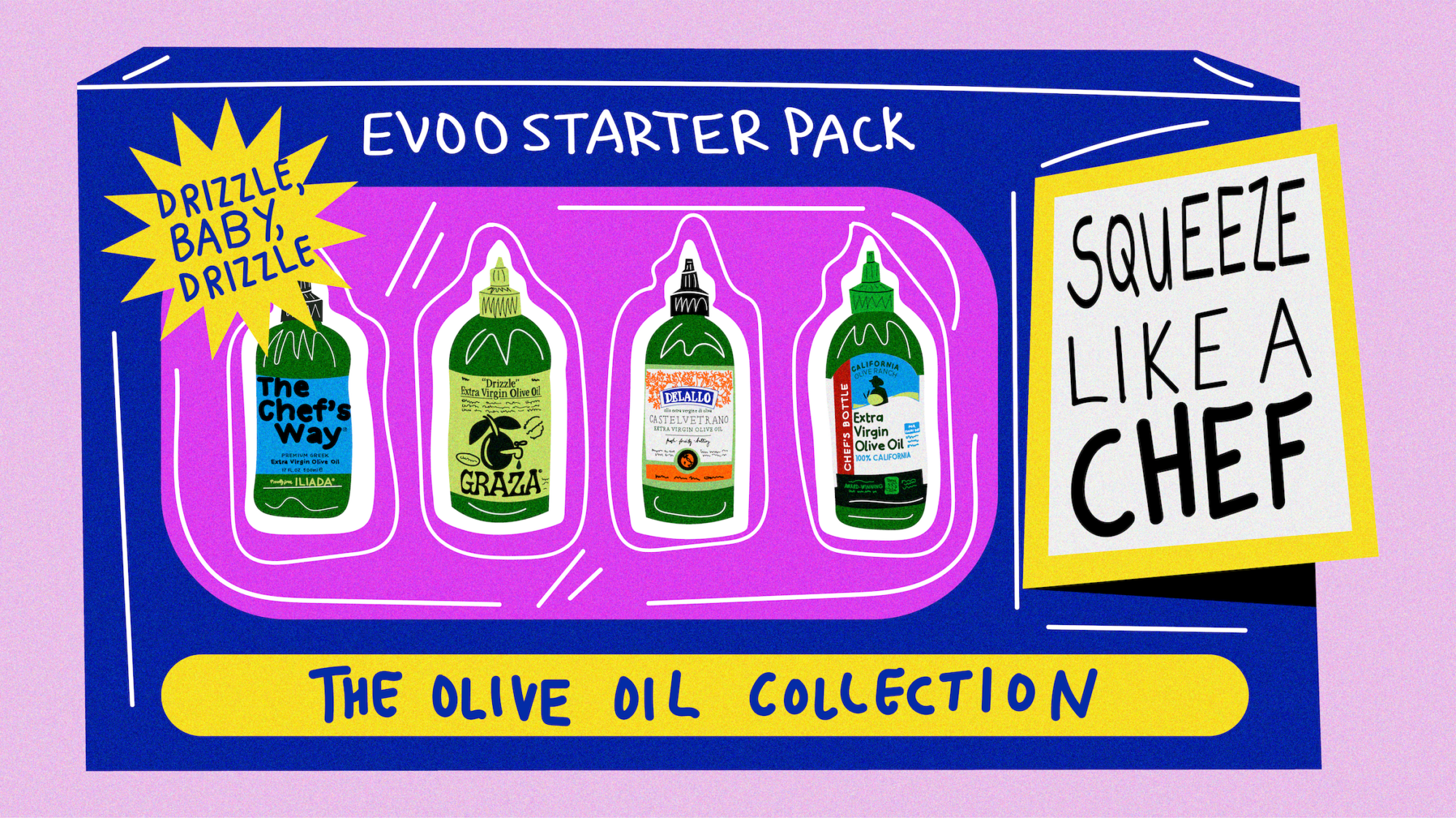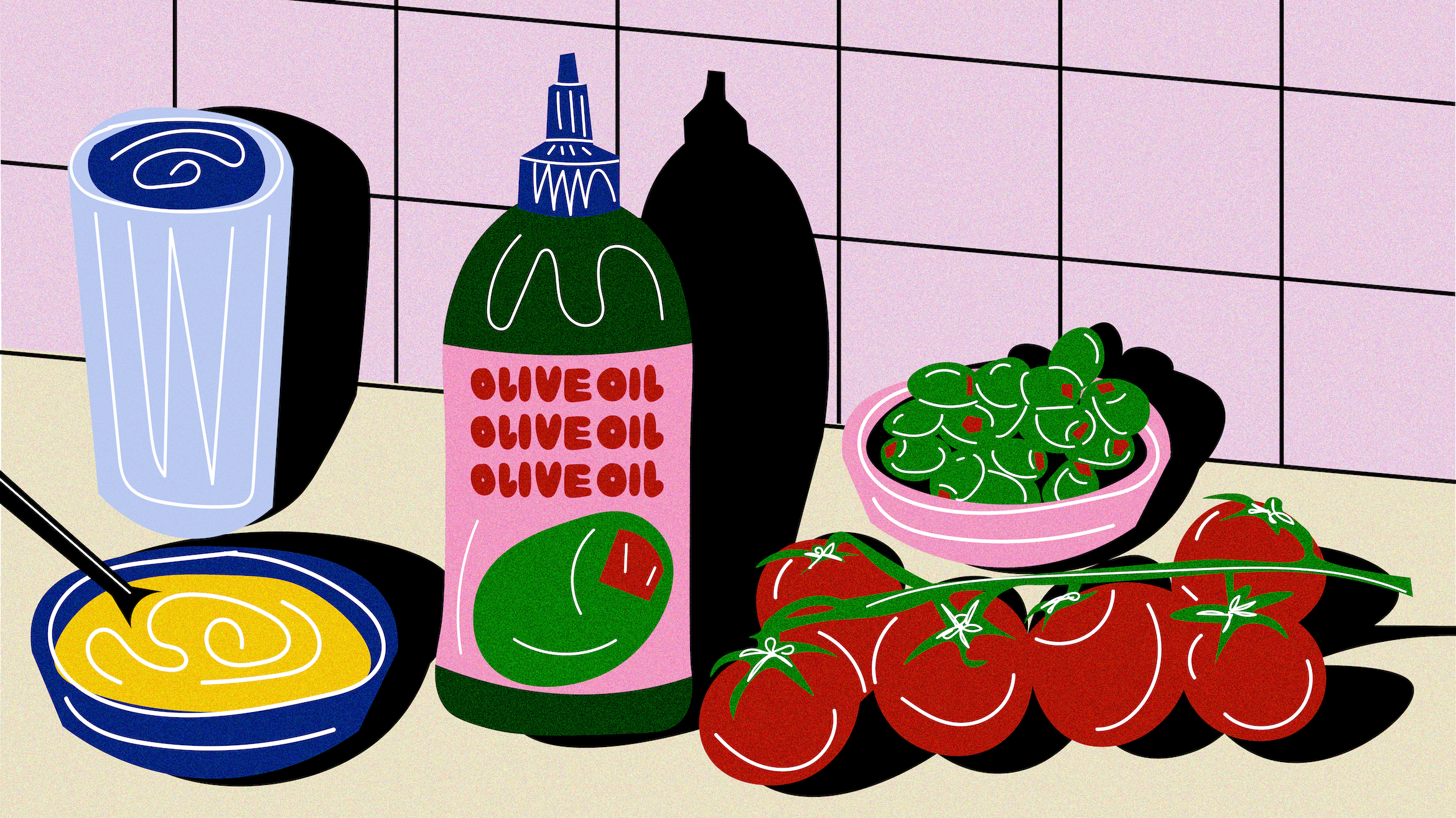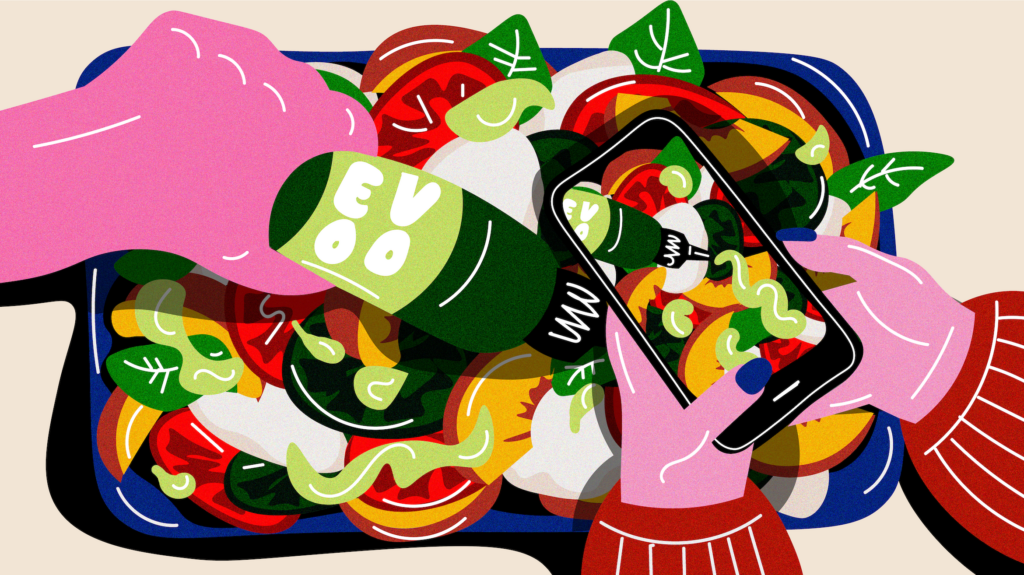
A start-up capitalized on chef-driven olive oil squeeze bottles. Conspicuously, legacy brands are launching look-alikes.
The upscale Korean fried chicken restaurant COQODAQ is a palace of post-pandemic, eat-to-be-seen glamour. Tucked in olive-green leather booths in New York’s Flatiron District, illuminated by an archway of lights and mirrors like an oversize vanity dresser, diners dive into caviar-topped nuggets and glazed chicken pieces placed on pedestaled platters. Along with each chicken assemblage comes a quartet of sauces: avocado crema, honey Dijon, gochujang barbecue, and Parmesan peppercorn. But instead of the typical ceramic dishes with little spoons, these sauces are served in cheap, industrial plastic squeeze bottles—the kind you might find in the back of the kitchen, rather than offered front of house.
It’s a cheeky detail that fits right in with today’s chef-driven food trends. In a culture where even fictional chefs are sex symbols and real ones have millions of social media followers, many professional kitchen habits have been passed on to regular homes—from wearing Crocs to using the right kosher salt. Today squeeze bottles are having a moment.
Chefs and restaurant workers have long decanted oils, vinegars, and other concoctions into soft, squeezy tubes for easy use on the line—and in their homes. With Sharpie-labeled masking tape strips specifying “sherry vin” or “canola,” these containers allow chefs to easily squirt, dot, and speckle dishes with precise amounts of liquid or sauce. The $13 billion global olive oil industry has recently taken note in the biggest way, offering oils in squeezable plastic bottles, often dubbed “chef’s bottles.”
The trend has caused a rapid disruption of the consumer packaged goods industry as brands chase the coattails of the wildly successful start-up Graza, prompting some to ask: Are there drawbacks to storing oil in this format? Is it always wise to follow the example of professional cooks in the home kitchen? And are squeeze bottles for oil here to stay?
Drizzle, Baby, Drizzle
In 2018, Andrew Benin was staging at Gramercy Tavern, the lauded farm-to-table restaurant in New York City, after leaving his corporate job at the mattress company Casper. There was a lot of drizzling from squeeze bottles at the garde manger station, where he helped prepare the restaurant’s iconic beef carpaccios and chicory salads. But Benin admits it hadn’t yet “clicked” to replicate these containers by the time he was building a brand of single-varietal extra-virgin olive oils in 2020.
“There was a hunch to differentiate from what was in the market with our packaging,” he recalls about that stage in his company’s development in a recent phone call. Benin had by then decided that his true calling was to be an entrepreneur in the food world, and he had secured contracts with olive oil producers in Spain. He and his team considered selling olive oil in pouches or Tetra Paks with plastic nozzles at the top. Then one day, as Benin was taking a shower, he ran out of his beloved Dr. Bronner’s liquid soap. He had an idea. He washed out the cylindrical plastic bottle and put olive oil in it instead. The next day, he opened Microsoft Paint (really), took a still from a Gordon Ramsay YouTube video, and drew a lime-green bottle with a squeeze top in the TV chef’s hands.
“And that was the idea—it was born in a day there,” he says of his brand’s packaging.
In January 2022, Benin launched Graza with two products: Sizzle, a lime-green-labeled extra-virgin cooking olive oil in a 750 milliliter, opaque dark-green plastic bottle with a twist-to-open nozzle; and Drizzle, an extra-virgin finishing olive oil in a shorter 500 milliliter bottle. Adopting a direct-to-consumer model bolstered by a social media influencer campaign rather than paid ads, Graza sold out of olive oil on its first day in business. Sales have continued to soar. Today Graza’s products are sold at more than 13,000 retailers throughout the United States, as well as on its own website, for a reported $48 million in annual sales.
The trend has caused a rapid disruption of the consumer packaged goods industry as brands chase the coattails of the wildly successful start-up Graza.
Graza’s overnight success has shaken the extra-virgin olive oil industry to its core. And conspicuously, over the past year, legacy brands have introduced their own oils in lookalike plastic squeeze bottles, including California Olive Ranch (“Chef’s Bottle™”), Iliada (“The Chef’s Way®”), Terra Delyssa (“Chef’s Edition”), Delallo, and more. In 2024, avocado oil from Chosen Foods joined the party too, sold in a “chef-inspired” plastic squeeze bottle. It’s a drastic departure for the extra-virgin olive oil industry, though, where quality and prestige have been conveyed through heavy, imposing glass bottles ever since EVOO became a US household staple in the 1990s. (Thank you, Rachael Ray.)
Lightweight, squeezable, and plastic, these new bottles would have seemed out of place shelved with the high-end options just a couple years ago. In 2023, after the direct-to-consumer competitor Brightland launched a “Pizza Oil” in a plastic squeeze bottle, Benin took to his LinkedIn account to call out its founder in a messy spat dubbed “olive oil copycat-gate.”
“We tested 300 different squeeze bottles before [settling on] this one—now everyone’s look like ours,” says Benin with a wry laugh.
Despite all that, Benin insists that the squeeze bottle is only a small part of Graza’s success—it’s the branding, the single-varietal Spanish Picual olives, the affordability, and the taste that have been most important. But he acknowledges that, for many customers, the tactile pleasure and control of using the plastic squeeze bottle is a revelation. Rather than pouring sloppy glugs of oil here and there and missing some spots completely (everyone has attempted to thin the flow by placing an index finger across the bottle’s mouth), home cooks could suddenly stand back and squeeze neat stripes of olive oil across a sheet pan full of cauliflower florets before roasting them. And rather than lose precious finishing oil to the countertop in an attempt to drizzle a bowl of soup, they could now squirt a smiley face followed by a chef’s kiss.

“Unless you live in a place where olive oil is plentiful, like somewhere in the Mediterranean, and you don’t mind pouring a ton of oil before you brown your garlic or whatever, these other formats are inferior,” he says of rigid bottles and metal jugs. “You’re either using too much or too little.”
When California Olive Ranch, the largest olive oil producer in the United States, launched its plastic Chef’s Bottle in 2024, its chief marketing officer, Stuart Beck, says he was “delightfully surprised” by its utility.
“I had seen chefs in restaurants using it, and after I tried it, it was like, ‘Oh, this is different than a large bottle,’” Beck recalls. “I was sautéing and I didn’t want to put in too much oil, but when you have heat on the pan, you want to do things quickly.”
Drizzling, sautéing—that’s where the squeeze bottle’s magic is, says Beck. But the California-grown olive oil in a signature chunky square glass bottle is still the 25-year-old company’s flagship product, and Beck expects it will remain so. He also cautions that the quality of extra-virgin olive oil kept in plastic bottles will have a shorter shelf life than with glass.
“From all our experience and testing, glass containers are still the best to maintain the quality of the oil long-term in your kitchen,” says Beck. “Now, if you’re cooking a lot and using it within a month or two, you’re not going to notice any difference. But if it is something that’s in your pantry for a longer time frame, like a few months, a glass bottle’s the best way to maintain the highest quality of your olive oil.”
In other words, a cheffy squeeze bottle is a fun way for consumers to feel the same kind of control and ease that professionals wield in their kitchens. But they should also be prepared to use up their cooking oil quickly—like in professional kitchens.
Benin points out that not all plastics are equal: the type of squeeze bottles used by chefs on the line, usually low-density polyethylene (LDPE) or high-density polyethylene (HDPE), are fine for daily use but far too porous to preserve olive oil long-term. Whereas Graza—along with the latest crop of olive oil brands to bottle in plastic—opts for the slightly more sturdy polyethylene terephthalate (PET).
Beck adds that California Olive Ranch’s plastic squeeze bottles are BPA-free and 100% recyclable. He encourages consumers to reuse them, but he warns about refilling the plastic bottles without first washing them out, as the remaining oil from the earlier contents will go rancid, affecting the overall taste of what’s put in them next.
A bit about EVOO spoilage: It’s not dangerous when oil goes rancid, but it doesn’t taste as good—and when you’re buying high-quality, expensive oil, you’ll want to preserve its flavor as long as you can. Extra-virgin olive oil is essentially cold-pressed olive juice, and it’s considered best when it’s as fresh as can be; like most natural products, its flavor and nutrient density will erode over time. Three things accelerate that decline: heat, oxygen, and light. Heat exposure is easy to prevent: Don’t keep olive oil right next to the stove. Oxygen exposure is minimized before you purchase the oil because producers typically add a dose of nitrogen inside the container, eliminating oxygen in the space between the oil and the container.
Once consumers break the seal, however, the countdown begins as oxidation gradually increases, producing off flavors (the North American Olive Oil Association advises giving a bottle three months after opening it). And the third element, light? Keeping olive oil in the pantry when not in use is advised. But dark glass—like the lizard-green-tinted bottles many brands use—does a better job of keeping light out than plastic.
This was noted by Beck as well as by scientific studies, including a 2014 report from the UC Davis Olive Center that compared materials used for storing olive oil and their influence on quality. Whatever its advantages over other types of plastic, the report’s authors also state that PET plastic has the disadvantage of being a porous material that admits humidity and gases, therefore shortening the lifespan of an oil’s quality compared with nonpermeable materials like dark glass.
“There are things that are rendered less good if they’re in plastic,” says David Neuman, an olive oil consultant, the former president of the extra-virgin olive oil company Lucini, and the author of Extra Virgin Olive Oil: The Truth in Your Kitchen, noting that tin is also problematic due to its ability to conduct heat. Extra-virgin olive oil is the highest grade of olive oil that can be sold, a product that, by law, has been processed without heat or chemicals and that was determined by a panel of blind tasters to be free of defects (rampant EVOO fraud notwithstanding). Tinted glass is the best material for EVOO, and that’s why you’ve seen it most often, he says. (Neuman has consulted and worked for numerous olive oil companies, which primarily sell in glass.)
“It’s not canola oil, which is like, who cares?” says Neuman. “EVOO is healthy, it’s a monounsaturated fat, it’s high in polyphenols, it’s high in antioxidants, it’s got anti-inflammatory properties—why would you want any of those positive attributes to be sold in a plastic bottle that can only damage the oil?” he asks.
“We’re All Plastic Maxxing”
Of course, concerns about plastic go beyond degrading the taste of good olive oil. Many are concerned about plastic’s ability to leach harmful chemicals into the foods it holds, especially when those foods or liquids are fats and oils. Then there’s the escalating threat of microplastics, and the massive amounts of plastic waste on the planet.
Auria Abraham, founder of Auria’s Malaysian Kitchen, says that one day her third grader came home from school in tears after learning about the Great Pacific Garbage Patch, which covers more than 1.6 million square kilometers of ocean halfway between Hawaii and California. Afterward, she says she went on an “all-out war” against plastic, shunning it from her kitchen. For a similar amount of control to that offered by squeeze bottles, she recommends using a glass oil decanter with a metal spout, something you can buy at a kitchenware or home goods store. Christine Wong, author of Living Without Plastic, says she uses a metal spout that attaches to a glass olive oil bottle to control the flow. It’s a simple fix to avoid the possibility of chemicals leaching into your food, she says.
Of course, olive oil isn’t the only kitchen staple sold in PET bottles. “We have had sauces—ketchup, mayo, margarine, cheese, for example—in squeezable PET for many years. So this is not really a packaging innovation,” says Dr. Claire Sand, the CEO of Packaging Technology and Research LLC and a professor at California Polytechnic State University.

As with plastic pouches, which I reported on last year, plastic bottles shouldn’t be a food-quality concern as long as they are used as intended, Sand says. However, that also requires trusting that the type of plastics that have been determined safe by the Food and Drug Administration are in fact safe. The science is moving fast, and regulations have historically not kept pace with studies, such as with PFAS (per- and polyfluoroalkyl substances) on paperboard food packaging, which the FDA banned just last year after 25 years of use.
Benin points out that olive oil is sold in plastic around the world: “I say, take a trip to an Italian or Spanish supermarket—see how much olive oil is sold there in a 500 milliliter plastic jug,” he says. Furthermore, olive oil tins and glass bottles often have liners or spouts made of plastic. To reduce plastic waste, Graza recently introduced aluminum “beer can” refills of both its Sizzle and Drizzle oils, which are nitrogen-sealed and designed to keep oil fresh as long as possible before being decanted into a squeeze bottle—or any other container. Benin says sales of the refills have been “incredibly strong” so far: “Folks adore the opportunity to refill and the quality preservation that our cans offer.”
Even if you only use the squeeze bottle for its contents before disposing of it, it’s still not among the most environmentally disastrous single-use plastics—which make up roughly half of all plastic waste—says Benin, because it’s meant to be used multiple times over weeks or months rather than in one sitting, like a plastic yogurt cup.
“I had seen chefs in restaurants using it, and after I tried it, it was like, ‘Oh, this is different than a large bottle.'”
The argument over glass versus plastic containers, from an environmental perspective, is a tricky one. The simple answer, which has been supported by numerous studies, is that plastic containers have a smaller carbon footprint than glass because they’re less energy-intensive to produce and—this is particularly significant for consumer packaged goods—lighter in weight and hence less energy-intensive to transport. But when you add in factors like microplastics in the ocean and toxic fumes in third-world countries where much of plastic waste is shipped (rather than being recycled), the calculation gets complicated. And with so much plastic all around us, eliminating plastic containers completely is an unrealistic proposition for most consumers.
“I generally don’t think that an average consumer is thinking, ‘Don’t buy Duke’s Mayonnaise because it’s in the plastic container’—or a myriad of other condiments,” says Andrea Hernández, founder of the Gen Z and millennial-oriented food and beverage industry newsletter Snaxshot.
“We’re all plastic maxxing,” she says with a laugh.
Hernández says she’s seen a “Graza-fication” of other products beyond olive oil—think Ayoh, the flavored mayo brand from Molly Baz (a former line cook) that comes in squeezable plastic bottles. And she feels that much of her generation’s love of squeezing and squiggling condiments may stem from sriracha, the hugely popular hot sauce sold in an iconic nozzle-topped squeeze bottle. She doesn’t see an end to this format anytime soon: “You can’t unlearn convenience,” says Hernández.
The other interesting part about this moment for extra-virgin olive oils, beyond plastics or squeezing, she says, is that the industry is perhaps catering to millennials and Gen Z for the first time. Some age-old industries have done this well: Fishwife has revived tinned fish for a new generation of Americans, and traditional Jewish food brands have launched—or in the case of Manischewitz, recently rebranded—to appeal to younger customers.
Millennials and Gen Z have a different relationship with food products than their predecessors, where brands are more visible than ever, so this matters. We’re filming ourselves all the time, explains Hernández, so our homes and kitchens become a set. “Our parents weren’t gathering with their friends and opening up their pantries to show that they had Heinz ketchup or Campbell’s soup,” says Hernández. Using the same brands as your favorite chefs or content creators can signal a kind of cultural cachet. She thinks the pandemic accelerated this trend, when people were stuck indoors and there was nobody to see their new handbags or Balenciaga shoes.
“The younger generation wants something that defines their time and place, and maybe this is the package that does it,” says David Neuman, the olive oil consultant. “Clearly there’s a market for them. But is it fair to sell customers extra-virgin olive oil in plastic that does not protect the oil and the premium-ness that the word ‘extra-virgin’ stands for?”
It’s a little ironic that, at the same time, some grocery categories are seeing a shift away from plastic in favor of more easily recyclable glass and aluminum containers—like better-for-you sodas, for instance. But once you’ve learned to drizzle, dollop, and squiggle from a lightweight squeeze bottle like Carmy or Molly or your favorite chef on TV? “No matter the hate or taboo against a plastic bottle, when a brand means convenience, it’s got something going,” says Hernández.